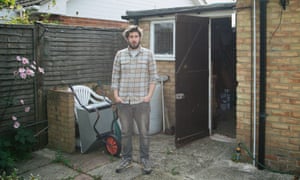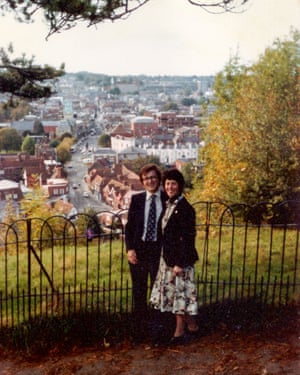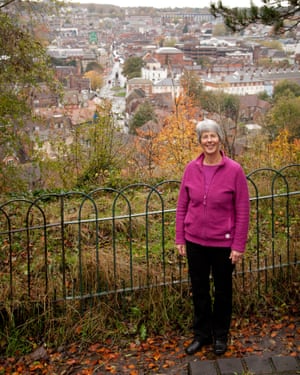How an old photograph has helped me with the death of my father | Life and style
‘If the sun was up and Dad was home, then he was probably in the garden with a cup of tea,†says Simon Bray. “In my childhood, everything happened out there.â€
While his father, Peter, tended flowers, lawn, fruit and vegetables, Simon and his sister, Jess, rode their bikes round a purpose-built paving loop, played football, helped to harvest the produce â€" enough for the family table, freezer and a jam-making church friend â€" and, most thrillingly, dug for treasure.
“I always found something â€" an old coin, a bit of pottery. I had my own little spade and Dad would tell me where to dig,†says Simon. “Quite recently I found out he had planted it all.â€

Peter died of prostate cancer, aged 51, in 2009. It was a few years later, while rooting through a box of photos at his grandmother’s house, that Simon, 29, came across a snap of himself, aged about three, red wellies on, sweeping the patio of that Winchester garden with his father.
The image now forms part of Loved and Lost (lovedandlostproject.co.uk), an online project Simon, a Manchester-based photographer, has created to help others who have experienced bereavement “to tell the story of a moment in time, acknowledge their loss and celebrate someone they loveâ€. It is, he adds, a way of honouring that person.
“I was looking for a way to represent loss in a simple, visual way,†he says. Participants choose a treasured picture of themselves with their deceased loved one. Simon restages and shoots it in the same location. The resulting photos â€" the second with its striking absence â€" are accompanied by an interview.
“The pictures create a structure for starting a conversation,†says Simon. There are, he says, no rules for where that might go. “I wanted to show it needn’t be complicated. Everyone’s experience of loss is unique. Every relationship is unique. We don’t all do it in the same way, but I think it can be hugely helpful to unlock memories, to revisit a place, perhaps for the first time and confront that experience, to talk about the person.â€
Sometimes, he has found, opportunities for this are scarce. “After he died, all I really wanted to do was talk about my dad but often we don’t know where to start discussing loss. And people around you may not ask what the person meant to you specifically, because they have their own memories to focus on.â€
Even now, says Simon, when Southampton play a football match, he is ready to call his father. “It was something we had always done together. It was a special thing just for us. My mum and my sister had their own particular relationships with him. When Dad died, I suddenly didn’t have the person to have those conversations with.â€
Though the idea sprang from his personal experience, Simon did not initially intend to include his own picture. It was the discovery of this image, and the fact that the house and garden â€" in which Simon had grown up â€" were about to be sold, which prompted the decision.
“It’s just a snap, in front of the garage doors, not at the nice, flourishing end of the garden. I don’t even remember it being taken, but it evokes and somehow solidifies so many happy times for which I feel very grateful,†says Simon, explaining why this picture in particular seemed immediately fitting.
“The most important thing to me is how much I clearly aspired to be like Dad, even then. We both have our brooms. I loved helping â€" in the loosest sense of the word â€" when he was out there, and he always encouraged me.â€
Peter’s illness developed over several years and, recalls Simon, the garden continued to provide an important point of contact through that time. “In the garden he could open up a bit,†says Simon. “Having that space and things to get on with made it easier for him to talk.†He was, Simon says, “a fairly quiet sort of guyâ€, ready with practical support and reassurance and always “providing for his family without expecting any fuss or fanfareâ€.
Towards the end of his life, Peter took time to show his son how to sow and harvest potatoes properly. “He was leaving me that as part of his legacy. It was important to him and I suppose it was also his way of letting me know how things were going. He didn’t explicitly say so but his treatment options were running out. I’m not sure I fully realised it at the time.â€
When the idea for the project came to Simon, about four years after his father’s death, he discussed it with his mother, Anne, 62. “I was looking for a way to use the skills I had to do something that might, hopefully, be meaningful for me and for others.†Immediately supportive, she offered the first photograph.

Taken in October 1981, the picture she chose shows the couple a few days after they had became engaged. They are standing on St Giles Hill above Winchester, Hampshire. Stretching below them is the town â€" seemingly little changed in the three decades between the pictures â€" with so many of the places that featured in their life together.
This contrast between the person now gone and the permanence â€" at least relatively â€" of the setting is, of course, part of what makes the images so arresting. Simon does not want this to be the sole focus of the exercise, though. “I hope there is some comfort in that continuity. For some of the people I have worked with, revisiting a place is hard but I hope it will bring the memories closer.†For some participants, he says, thinking about happy times is a welcome relief after a period of illness.
Selecting the right image was not difficult for Anne. “Mum knew pretty much straight away that this was the one she wanted to use,†says Simon. Coincidentally, without having been aware of this picture, he had also chosen the same spot to propose to his wife, Sarah.

“It wasn’t somewhere they went amazingly regularly but this photograph took her back to a very happy time, the start of a new chapter.†After meeting at church, the couple had known each other less than a year. Peter had tried to propose twice in that time, with Anne telling him she wasn’t yet ready. “I guess he was persistent. He really knew. They must have been very excited and they had so much ahead of them at that point.â€
Taking the picture â€" which Simon did with the help of another photographer friend â€" was necessarily a quick job because of drizzly weather. Afterwards, over a cup of tea, Simon’s friend asked Anne about the picture she had chosen.
“I thought Mum would respond differently to someone else. With me she would have presumed I knew things,†he explains. Hearing about his parents as a young couple, before they were in any way defined by parenthood, was an opportunity for which Simon says he is grateful.
Learning more about a time he had never known in his parents’ lives was emotional, but also a privilege, says Simon. “I had never really had reason to hear much about those times, their ‘courting’, as they might have called it. It was different seeing them in that way.â€
For Anne, having an opportunity to talk not just about the sadness of bereavement, the practicalities of coping and building a new solo life, but also about Peter as a person, was welcome and comforting. “I just knew I liked him as soon as I met him. He was gentle and kind, intelligent and practical,†she recalled in her interview.
“It is a very healthy thing to have a chance to say why a person was special, what they were like. For Mum, this was the person she had committed to spending the rest of her life with,†says Simon.
In several of the pictures â€" including Simon’s and his mother’s â€" there are broad smiles (though Simon leaves expression entirely to the participant). “I didn’t want this to be a project about sadness. It is about relationships. The starting point is a happy memory.â€
• For more information, including how to participate, see lovedandlostproject.co.uk

0 Response to "How an old photograph has helped me with the death of my father | Life and style"
Posting Komentar